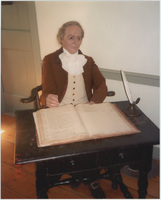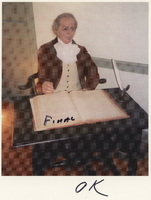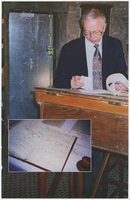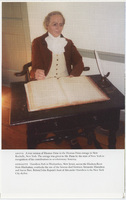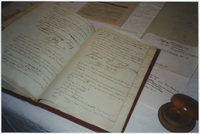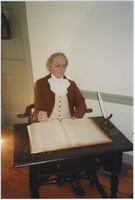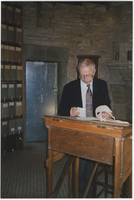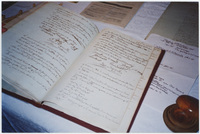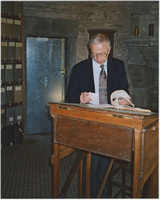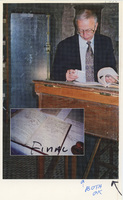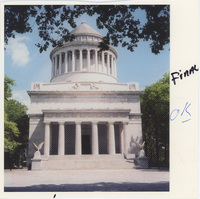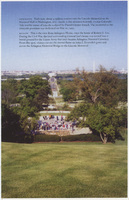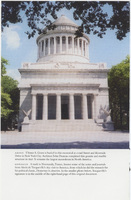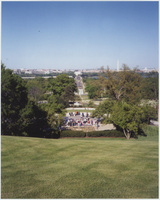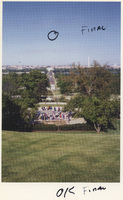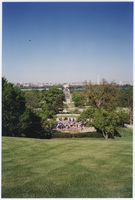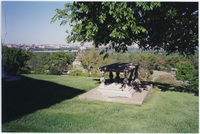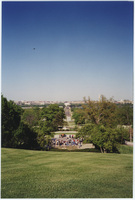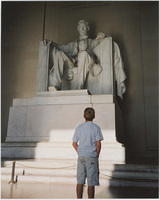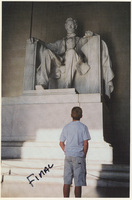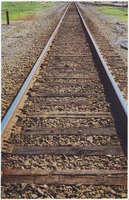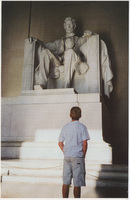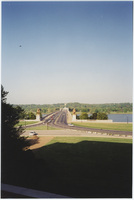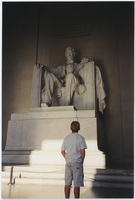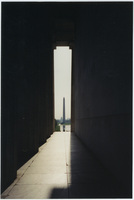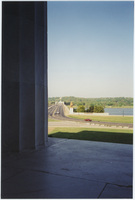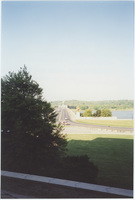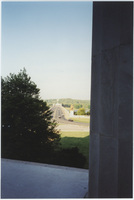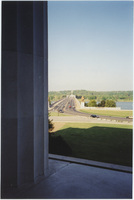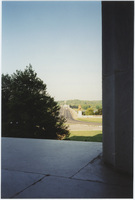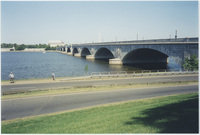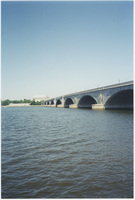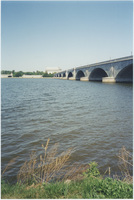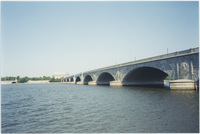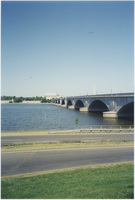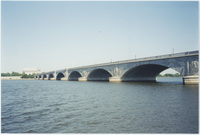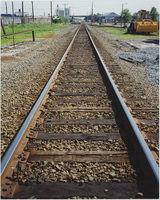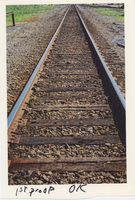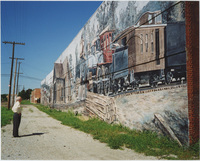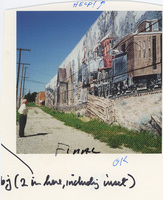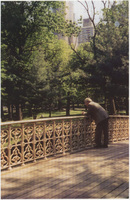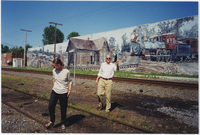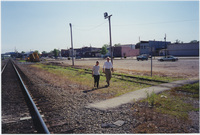Search
4210 items
-
Thomas Paine wax figure, Thomas Paine Cottage, New Rochelle, New York
A wax version of Thomas Paine in the Thomas Paine Cottage in New Rochelle, New York. The cottage was given to Mr. Paine by the state of New York in recognition of his contributions to revolutionary America. -
Thomas Paine wax figure, Thomas Paine Cottage, New Rochelle, New York
A wax version of Thomas Paine in the Thomas Paine Cottage in New Rochelle, New York. The cottage was given to Mr. Paine by the state of New York in recognition of his contributions to revolutionary America. -
Thomas Paine wax figure, Thomas Paine Cottage, New Rochelle, New York
A wax version of Thomas Paine in the Thomas Paine Cottage in New Rochelle, New York. The cottage was given to Mr. Paine by the state of New York in recognition of his contributions to revolutionary America. -
John Splaine in vault in Normandy, France
John E. Splaine examining records. A vault in Normandy, France, houses some of the notes and journals from Alexis de Tocqueville's 1831 visit to America, from which he did the research for his political classic, Democracy in America. In the smaller photo below, Tocqueville's signature is in the middle of the right-hand page of this original government. -
Thomas Paine wax figure, Thomas Paine Cottage, New Rochelle, New York and Hamilton Park caption
A wax figurine of Thomas Paine, accompanied by the following text: "Above: A wax version of Thomas Paine in the Thomas Paine Cottage in New Rochelle, New York. The cottage was given to Mr. Paine by the state of New York in recognition of his contributions to revolutionary America.; Opposite: Hamilton Park in Weehawken, New Jersey, across the Hudson River from Manhattan, overlooks the site of the famous duel between Alexander Hamilton and Aaron Burr. Behind John Rapetti's bust of Alexander Hamilton is the New York City skyline." -
Vault in Normandy, France
A vault in Normandy, France, houses some of the notes and journals from Alexis de Tocqueville's 1831 visit to America, from which he did the research for his political classic, Democracy in America. Tocqueville's signature is in the middle of the right-hand page of this original government. -
Thomas Paine wax figure, Thomas Paine Cottage, New Rochelle, New York
A wax version of Thomas Paine in the Thomas Paine Cottage in New Rochelle, New York. The cottage was given to Mr. Paine by the state of New York in recognition of his contributions to revolutionary America. -
John Splaine in vault in Normandy, France
John E. Splaine examining records. A vault in Normandy, France, houses some of the notes and journals from Alexis de Tocqueville's 1831 visit to America, from which he did the research for his political classic, Democracy in America. -
Vault in Normandy, France
A vault in Normandy, France, houses some of the notes and journals from Alexis de Tocqueville's 1831 visit to America, from which he did the research for his political classic, Democracy in America. Tocqueville's signature is in the middle of the right-hand page of this original government. -
John Splaine in vault in Normandy, France
John E. Splaine examines records. A vault in Normandy, France, houses some of the notes and journals from Alexis de Tocqueville's 1831 visit to America, from which he did the research for his political classic, Democracy in America. -
John Splaine in vault in Normandy, France
John E. Splaine examining records. A vault in Normandy, France, houses some of the notes and journals from Alexis de Tocqueville's 1831 visit to America, from which he did the research for his political classic, Democracy in America. -
Ulysses S. Grant memorial, New York City
Ulysses S. Grant is buried in this memorial at 122nd Street and Riverside Drive in New York City. Architect John Duncan completed this granite and marble structure in 1897. It remains the largest mausoleum in North America. -
Ulysses S. Grant memorial, New York City
Ulysses S. Grant is buried in this memorial at 122nd Street and Riverside Drive in New York City. Architect John Duncan completed this granite and marble structure in 1897. It remains the largest mausoleum in North America. -
Arlington House view to Lincoln Memorial
A photo from the view of the Arlington House, accompanied by the following text: "Opposite: Each year, about 4 million tourists visit the Lincoln Memorial on the National Mall in Washington, D.C. Inside is this nineteen-foot-tall, 175-ton Colorado Yule marble statue of Lincoln sculpted by Daniel Chester French. The memorial to the sixteenth President was dedicated on May 30, 1922.; Below: This is the view from Arlington House, once the home of Robert E. Lee. During the Civil War, the land surrounding General Lee's home was turned into a burial ground for the Union Army that later became Arlington National Cemetery. From this spot, visitors can see the eternal flame on John F. Kennedy's grave and across the Arlington Memorial Bridge to the Lincoln Memorial." -
Ulysses S. Grant memorial, New York City and Vault in Normandy, France caption
A photo of Ulysses S. Grant memorial, accompanied by the following text: "Above: Ulysses S. Grant is buried in this memorial at 122nd Street and Riverside Drive in New York City. Architect John Duncan completed this granite and marble structure in 1897. It remains the largest mausoleum in North America.; Opposite: A vault in Normandy, France, houses some of the notes and journals from Alexis de Tocqueville's 1831 visit to America, from which he did the research for his political classic, Democracy in America. In the smaller photo below, Tocqueville's signature is in the middle of the right-hand page of this original government." -
Ulysses S. Grant memorial, New York City
Ulysses S. Grant is buried in this memorial at 122nd Street and Riverside Drive in New York City. Architect John Duncan completed this granite and marble structure in 1897. It remains the largest mausoleum in North America. -
View from Arlington House, Arlington, Virginia
This is the view from Arlington House, once the home of Robert E. Lee. During the Civil War, the land surrounding General Lee's home was turned into a burial ground for the Union Army that later became Arlington National Cemetery. From this spot, visitors can see the eternal flame on John F. Kennedy's grave and across the Arlington Memorial Bridge to the Lincoln Memorial. -
View from Arlington House, Arlington, Virginia
This is the view from Arlington House, once the home of Robert E. Lee. During the Civil War, the land surrounding General Lee's home was turned into a burial ground for the Union Army that later became Arlington National Cemetery. From this spot, visitors can see the eternal flame on John F. Kennedy's grave and across the Arlington Memorial Bridge to the Lincoln Memorial. -
Woman in grass by Custis-Lee mansion, Arlington, Virginia
A woman sitting on the grass in front of the Custis-Lee mansion (aka Arlington House) in Arlington National Cemetery, looking out over the cemetery and Memorial Bridge. -
View from Arlington House, Arlington, Virginia
This is the view from Arlington House, once the home of Robert E. Lee. During the Civil War, the land surrounding General Lee's home was turned into a burial ground for the Union Army that later became Arlington National Cemetery. From this spot, visitors can see the eternal flame on John F. Kennedy's grave and across the Arlington Memorial Bridge to the Lincoln Memorial. -
Woman in grass by Custis-Lee mansion, Arlington, Virginia
A woman sitting on the grass in front of the Custis-Lee mansion (aka Arlington House) in Arlington National Cemetery, looking out over the cemetery and Memorial Bridge. -
Pierre L'Enfant grace, Arlington National Cemetery, Arlington, Virginia
The grave of Pierre L'Enfant in Arlington National Cemetery, overlooking the cemetery and Memorial Bridge to Washington, D.C. -
View from Arlington House, Arlington, Virginia
This is the view from Arlington House, once the home of Robert E. Lee. During the Civil War, the land surrounding General Lee's home was turned into a burial ground for the Union Army that later became Arlington National Cemetery. From this spot, visitors can see the eternal flame on John F. Kennedy's grave and across the Arlington Memorial Bridge to the Lincoln Memorial. -
View from Arlington House, Arlington, Virginia
This is the view from Arlington House, once the home of Robert E. Lee. During the Civil War, the land surrounding General Lee's home was turned into a burial ground for the Union Army that later became Arlington National Cemetery. From this spot, visitors can see the eternal flame on John F. Kennedy's grave and across the Arlington Memorial Bridge to the Lincoln Memorial. -
Lincoln Memorial, Washington, D.C.
Each year, about 4 million tourists visit the Lincoln Memorial on the National Mall in Washington, D.C. Inside is this nineteen-foot-tall, 175-ton Colorado Yule marble statue of Lincoln sculpted by Daniel Chester French. This memorial to the sixteenth President was dedicated on May 30, 1922. -
Lincoln Memorial, Washington, D.C.
Each year, about 4 million tourists visit the Lincoln Memorial on the National Mall in Washington, D.C. Inside is this nineteen-foot-tall, 175-ton Colorado Yule marble statue of Lincoln sculpted by Daniel Chester French. This memorial to the sixteenth President was dedicated on May 30, 1922. -
Railroad in Paragould, Arkansas
The railroad track in Paragould, Arkansas, was built to carry cotton from Texas to St. Louis in the middle of the nineteenth century. Peter Marshall , Brian Lamb's grandfather, worked on this railroad in the early 1920s. J.W. Paramore's Texas and St. Louis small gauge rail line intersected with the St. Louis and Iron Mountain Railroad headed by Jay Gould in the northwest corner of Arkansas. People living at the junction named their new town Paragould in honor of the two railroad Presidents. -
Lincoln Memorial, Washington, D.C.
Each year, about 4 million tourists visit the Lincoln Memorial on the National Mall in Washington, D.C. Inside is this nineteen-foot-tall, 175-ton Colorado Yule marble statue of Lincoln sculpted by Daniel Chester French. This memorial to the sixteenth President was dedicated on May 30, 1922. -
View of Memorial Bridge and Arlington Cemetery from Lincoln Memorial, Washington, D.C.
The view of Memorial Bridge and the Custis-Lee mansion (aka Arlington House) in Arlington Cemetery from the Lincoln Memorial. -
Lincoln Memorial, Washington, D.C.
Each year, about 4 million tourists visit the Lincoln Memorial on the National Mall in Washington, D.C. Inside is this nineteen-foot-tall, 175-ton Colorado Yule marble statue of Lincoln sculpted by Daniel Chester French. This memorial to the sixteenth President was dedicated on May 30, 1922. -
View of Washington Monument from Lincoln Memorial, Washington, D.C.
The view of the Washington monument from a vantage point inside the Lincoln Memorial. Photo credit: Brian Lamb. -
View of Memorial Bridge and Arlington Cemetery from Lincoln Memorial, Washington, D.C.
A view of Memorial Bridge and the Custis-Lee mansion (aka Arlington House) in Arlington Cemetery from the Lincoln Memorial. -
View of Memorial Bridge and Arlington Cemetery from Lincoln Memorial, Washington, D.C.
A view of Memorial Bridge and the Custis-Lee mansion (aka Arlington House) in Arlington Cemetery from the Lincoln Memorial. -
View of Memorial Bridge and Arlington Cemetery from Lincoln Memorial, Washington, D.C.
A view of Memorial Bridge and the Custis-Lee mansion (aka Arlington House) in Arlington Cemetery from the Lincoln Memorial. -
View of Memorial Bridge and Arlington Cemetery from Lincoln Memorial, Washington, D.C.
A view of Memorial Bridge and the Custis-Lee mansion (aka Arlington House) in Arlington Cemetery from the Lincoln Memorial. -
View of Memorial Bridge and Arlington Cemetery from Lincoln Memorial, Washington, D.C.
A view of Memorial Bridge and the Custis-Lee mansion (aka Arlington House) in Arlington Cemetery from the Lincoln Memorial. -
View of Memorial Bridge over the Potomac River, Arlington, Virginia to Lincoln Memorial, Washington, D.C.
A view of Memorial Bridge over the Potomac River with the Lincoln Memorial in the distance. -
View of Memorial Bridge over the Potomac River, Arlington, Virginia to Lincoln Memorial, Washington, D.C.
A view of Memorial Bridge over the Potomac River with the Lincoln Memorial in the distance. -
View of Memorial Bridge over the Potomac River, Arlington, Virginia to Lincoln Memorial, Washington, D.C.
A view of Memorial Bridge over the Potomac River with the Lincoln Memorial in the distance. -
View of Memorial Bridge over the Potomac River, Arlington, Virginia to Lincoln Memorial, Washington, D.C.
A view of Memorial Bridge over the Potomac River with the Lincoln Memorial in the distance. -
View of Memorial Bridge over the Potomac River, Arlington, Virginia to Lincoln Memorial, Washington, D.C.
A view of Memorial Bridge over the Potomac River with the Lincoln Memorial in the distance. -
View of Memorial Bridge over the Potomac River, Arlington, Virginia to Lincoln Memorial, Washington, D.C.
A view of Memorial Bridge over the Potomac River with the Lincoln Memorial in the distance. -
Railroad in Paragould, Arkansas
The railroad track in Paragould, Arkansas, was built to carry cotton from Texas to St. Louis in the middle of the nineteenth century. Peter Marshall , Brian Lamb's grandfather, worked on this railroad in the early 1920s. J.W. Paramore's Texas and St. Louis small gauge rail line intersected with the St. Louis and Iron Mountain Railroad headed by Jay Gould in the northwest corner of Arkansas. People living at the junction named their new town Paragould in honor of the two railroad Presidents. -
Railroad in Paragould, Arkansas
The railroad track in Paragould, Arkansas, was built to carry cotton from Texas to St. Louis in the middle of the nineteenth century. Peter Marshall , Brian Lamb's grandfather, worked on this railroad in the early 1920s. J.W. Paramore's Texas and St. Louis small gauge rail line intersected with the St. Louis and Iron Mountain Railroad headed by Jay Gould in the northwest corner of Arkansas. People living at the junction named their new town Paragould in honor of the two railroad Presidents. -
Railroad Heritage Mural, Paragould, Arkansas
Brian Lamb looks at the Railroad Heritage Mural; Paragould, Arkansas. The Railroad Heritage Mural painted by Connie Burns Wilkins of Paragould, Arkansas. Dedicated in 1990, this 205-by-25 foot mural took eleven months to paint and is located in downtown Paragould. -
Railroad Heritage Mural, Paragould, Arkansas
Brian Lamb looks at the Railroad Heritage Mural; Paragould, Arkansas. The Railroad Heritage Mural painted by Connie Burns Wilkins of Paragould, Arkansas. Dedicated in 1990, this 205-by-25 foot mural took eleven months to paint and is located in downtown Paragould. -
Peter Osnos on Pine Bank Bridge, Central Park, New York City
Peter Osnos leaning on the rail of Pine Bank Bridge in Central Park, New York City. -
Brian Lamb with Railroad Heritage Mural in Paragould, Arkansas and Railroad in Paragould caption
Photo of Brian Lamb looking at the Railroad Heritage Mural in Paragould, Arkansas, accompanied by the following text: "Above: The Railroad Heritage Mural painted by Connie Burns Watkins of Paragould, Arkansas. Dedicated in 1990, this 205-by-25 foot mural took eleven months to paint and is located in downtown Paragould.; Opposite: The railroad track in Paragould, Arkansas, was built to carry cotton from Texas to St. Louis in the middle of the nineteenth century. Peter Marshall , the author's grandfather, worked on this railroad in the early 1920s. J.W. Paramore's Texas and St. Louis small gauge rail line intersected with the St. Louis and Iron Mountain Railroad headed by Jay Gould in the northwest corner of Arkansas. People living at the junction named their new town Paragould in honor of the two railroad Presidents." -
Victoria Lamb and Henry Goldberg by Railroad Heritage Mural, Paragould, Arkansas
Victoria Lamb and Henry Goldberg by the Railroad Heritage Mural in Paragould, Arkansas. The Railroad Heritage Mural painted by Connie Burns Wilkins of Paragould, Arkansas. Dedicated in 1990, this 205-by-25 foot mural took eleven months to paint and is located in downtown Paragould. -
Railroad in Paragould, Arkansas
Victoria Lamb and Henry Goldberg by the railroad track in Paragould, Arkansas. This railroad track was built to carry cotton from Texas to St. Louis in the middle of the nineteenth century. Peter Marshall , the author's grandfather, worked on this railroad in the early 1920s. J.W. Paramore's Texas and St. Louis small gauge rail line intersected with the St. Louis and Iron Mountain Railroad headed by Jay Gould in the northwest corner of Arkansas. People living at the junction named their new town Paragould in honor of the two railroad Presidents.
